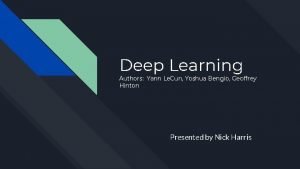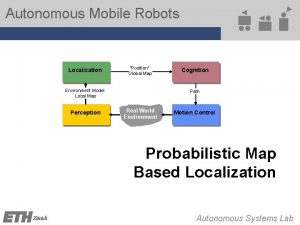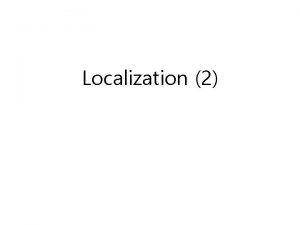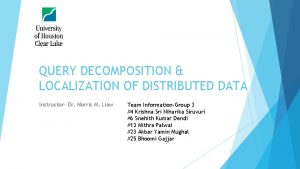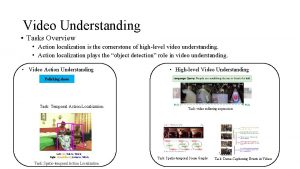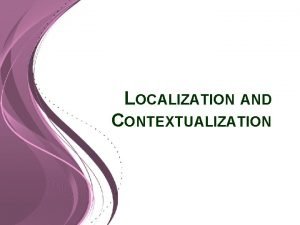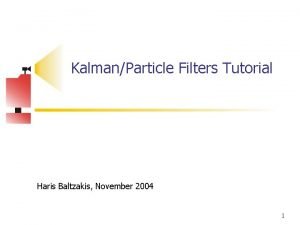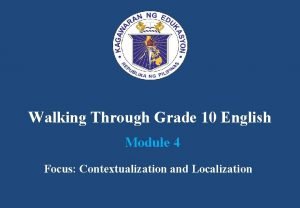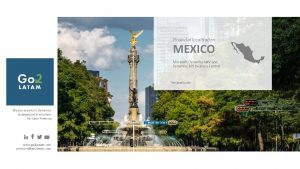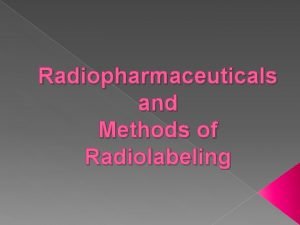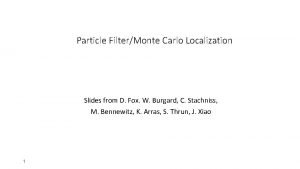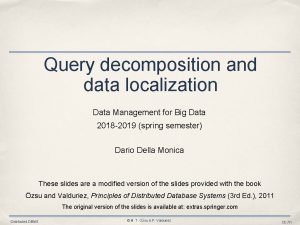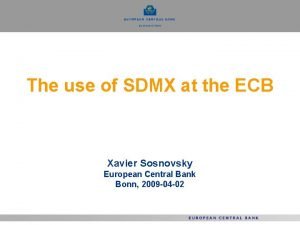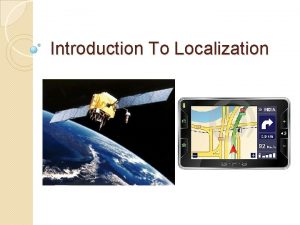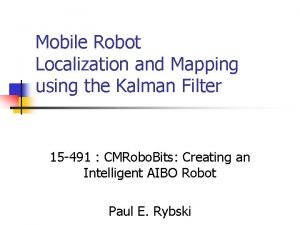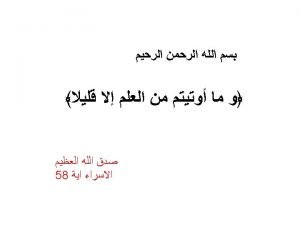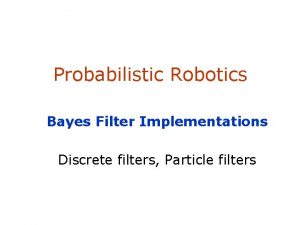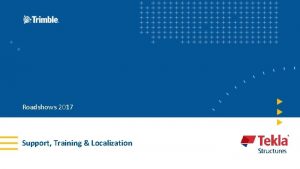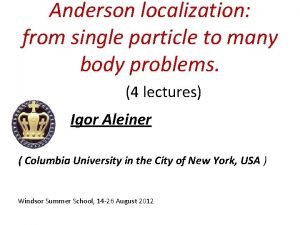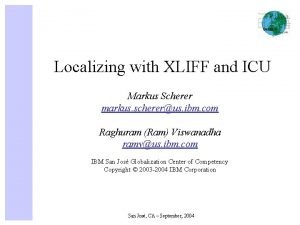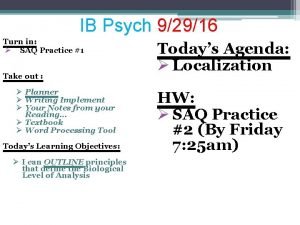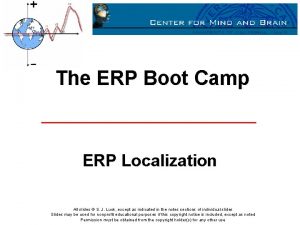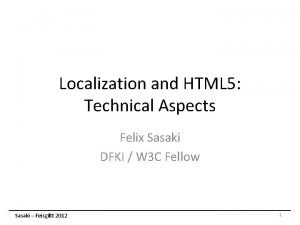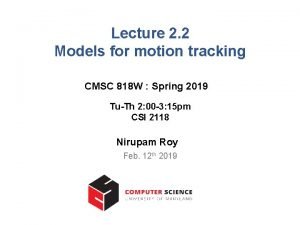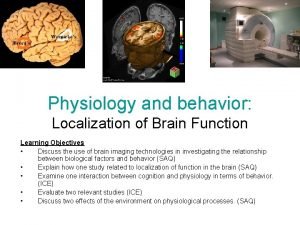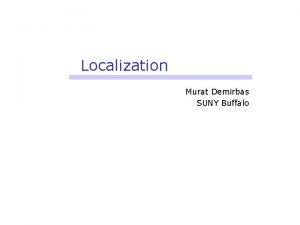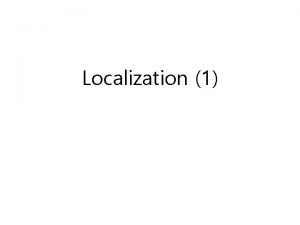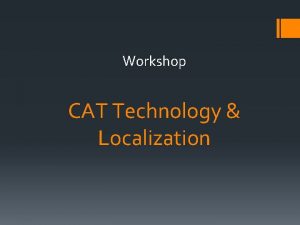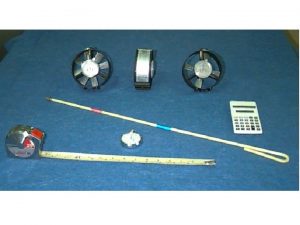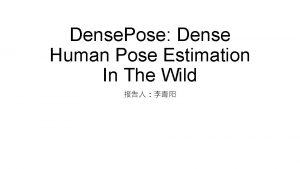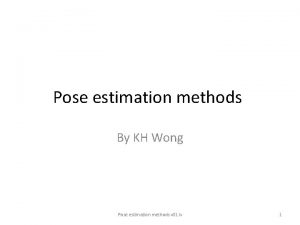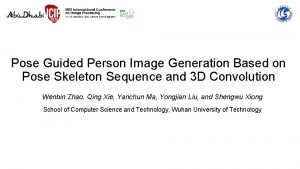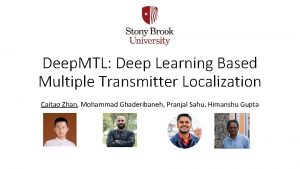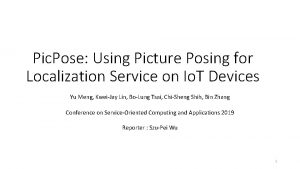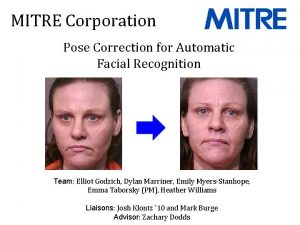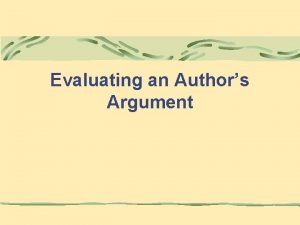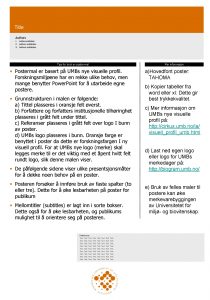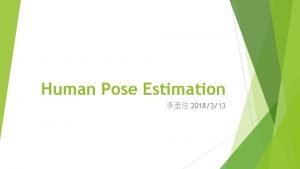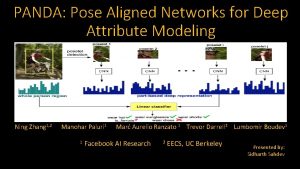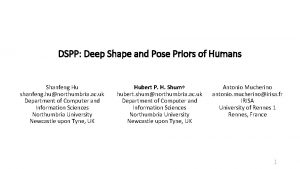DPCNet Deep Pose Correction for Visual Localization Authors
























![EXPERIMENTS-Training • All images resized to [400, 120] pixels. • Training datasets contained between EXPERIMENTS-Training • All images resized to [400, 120] pixels. • Training datasets contained between](https://slidetodoc.com/presentation_image_h2/d46ff89732dfa676ead5684274a58bda/image-25.jpg)












- Slides: 37

DPC-Net: Deep Pose Correction for Visual Localization Authors: Valentin Peretroukhin, Jonathan Kelly Presented by: Hussein Almulla

Main Idea • They “proposed an approach that uses a convolutional neural network to learn difficult-tomodel corrections to the estimator from ground-truth training data. ”

Localization in Robotics • various sensors, techniques, and systems for mobile robot positioning, such as – Wheel Odometry, – Laser/Ultrasonic Odometry, – Global Position System (GPS), – Inertial Navigation System (INS), – And Visual Odometry (VO),

Visual Odometry • Visual odometry (VO) : estimating the egomotion of an agent using the input of a single or multiple cameras attached to it. • By examining of the changes that motion induces on the images, and it is [3]: – An inexpensive – more accurate than GPS, INS, wheel odometry, and sonar localization – with a relative position error ranging from 0. 1 to 2% – not affected by wheel slip like wheel odometry.

Visual Odometry • To work effectively, requires: – sufficient illumination in the environment – a static scene with enough texture to allow apparent motion to be extracted. – Consecutive frames should have sufficient scene overlapping.

Stereo VO •

Stereo Visual Odometry From The paper: Multi-frame Feature Integration for Multi-camera Visual Odometry

Working Principle Image 1 Copyright of Davide Scaramuzza - davide. scaramuzza@ieee. org - https: //sites. google. com/site/scarabotix/ Image 2

Undistort

Rectify

Rectify

Feature Detection

Scheme of the visual odometry algorithm Modified from the paper: «Stereo vision specific models for particle filter-based SLAM”

Feature Tracking • The matching between two features is performed by applying a p × p pixels cross-correlation on them. • The cross-correlation process is done between each feature in the first frame and a sub-set of features in the second frame. • Those features must be closer than dn pixels from the position of the first frame feature.

Outlier Rejection

Motion Estimation • Estimate a rotation and a translation matrixes that transform the set of points corresponding to the features from the first frame into the set points of their pairs of the second frame. • Video about Visual odometry: • https: //www. youtube. com/watch? v=c 4 LMJJCc. SC 0 • https: //www. youtube. com/watch? v=t. P 1 GFap. Gal. Q

Structure from Motion (SFM) • SFM is more general than VO and tackles the problem of 3 D reconstruction of both the structure and camera poses from unordered image sets • The final structure and camera poses are typically refined with an offline optimization. • https: //www. youtube. com/watch? v=s. Qeg. Ero 5 Bfo Modified from slides: “Tutorial on Visual Odometry”, by Davide Scaramuzza

Visual Odometry • VO: suffer from several systematic error sources: Ø Estimator biases. Ø Poor calibration. Ø Environmental factors

Deep Pose Correction network (DPC-Net)

Stride, kernel size, input output channels of for each convolution. • No max pooling to preserve spatial information • ξ is 6 -Do. F pose vector,

Problem •

Loss for Corrections • They derived a loos function for learning pose corrections: • Given two stereo image pairs, they use the output of DPC-Net, ξ, to correct the estimator as follows:

Loss for Corrections • They computed the covariance-based tensor, that balance the rotation and translation loss, from training data: Where • They derived gradient (“compute Jacobian”), respect to the network output, ξ, for back-propagation:

EXPERIMENTS • They used the KITTI odometry benchmark training set. KITTI – Consists of 22 stereo sequences, in png forma: – 11 sequences (00 -10) with ground truth trajectories for training, and – 11 sequences (11 -21) without ground truth for evaluation • They used eight sequences 00, 02 and 05 -10 • For testing and validation, they used the first three sequences (00, 02, and 05). • 06 -10 used for training.
![EXPERIMENTSTraining All images resized to 400 120 pixels Training datasets contained between EXPERIMENTS-Training • All images resized to [400, 120] pixels. • Training datasets contained between](https://slidetodoc.com/presentation_image_h2/d46ff89732dfa676ead5684274a58bda/image-25.jpg)
EXPERIMENTS-Training • All images resized to [400, 120] pixels. • Training datasets contained between 35, 000 and 52, 000 training samples. • They trained all models for 30 epochs using the Adam optimizer, and selected the best epoch based on the lowest validation loss. • Train rotation-only corrections in addition to pose correction.

Estimators •

Estimators • Sparse Visual Odometry with Radial Distortion: – They modified the input images to test with degraded visual data. – They applied radial distortion to the (rectified) KITTI dataset to simulated a poorly calibrated lens. – They computed S-VO localization estimates and then trained DPC-Net.

Estimators • Dense (direct) Visual Odometry: – Pixel intensity values are used for both motion estimation and stereo matching. – It used for comparation with their proposed method

Evaluation Metrics • They used three error metrics to evaluate the performance of DPC-Net: – Mean absolute trajectory error. – Cumulative absolute trajectory error. – Mean segment error.



Results

Results

Results

Reference 1. Peretroukhin, Valentin and Jonathan Kelly. “DPC-Net: Deep Pose Correction for Visual Localization. ” Co. RR abs/1709. 03128 (2017). 2. Singh, Avi “Visual Odmetry from scratch - A tutorial for beginners”, May, 2015, https: //avisingh 599. github. io/vision/visual-odometry-full 3. Aqel, Mohammad O. A. et al. “Review of Visual Odometry: Types, Approaches, Challenges, and Applications. ” Springer. Plus 5. 1 (2016): 1897. PMC. Web. 18 Apr. 2018. 4. Nistér, David, Oleg Naroditsky, and James Bergen. "Visual odometry. " Computer Vision and Pattern Recognition, 2004. CVPR 2004. Proceedings of the 2004 IEEE Computer Society Conference on. Vol. 1. Ieee, 2004. 5. F. A. Moreno, J. L. Blanco, J. Gonzalez, “Stereo vision specific models for particle filter-based SLAM”, Robotics and Autonomous Systems, Volume 57, Issue 9, , 2009. 6. MATLAB Documentations.

Authors video • https: //www. youtube. com/watch? v=j 9 jn. Lld. UAkc

Thank you Question?
 Deep learning yoshua bengio authors
Deep learning yoshua bengio authors Deep asleep deep asleep it lies
Deep asleep deep asleep it lies Deep forest towards an alternative to deep neural networks
Deep forest towards an alternative to deep neural networks 深哉深哉耶穌的愛
深哉深哉耶穌的愛 Linguistic quality assurance
Linguistic quality assurance Dnn roadmap
Dnn roadmap Markov localization
Markov localization Concept of probability
Concept of probability Localisation of distributed data
Localisation of distributed data Action localization
Action localization Curriculum shall be contextualized and global
Curriculum shall be contextualized and global Miller's technique in radiology
Miller's technique in radiology Markov localization
Markov localization Example of contextualization and localization
Example of contextualization and localization Localization globalization testing
Localization globalization testing Dynamics nav localization
Dynamics nav localization Method of localization of radiopharmaceuticals
Method of localization of radiopharmaceuticals Monte carlo localization python
Monte carlo localization python Localization of distributed data in distributed database
Localization of distributed data in distributed database Ecb sdmx
Ecb sdmx Localisation industry standards association
Localisation industry standards association Localization in mobile computing
Localization in mobile computing Monte carlo localization for mobile robots
Monte carlo localization for mobile robots Voice localization using nearby wall reflections
Voice localization using nearby wall reflections Mobile robot localization
Mobile robot localization Crude touch
Crude touch Legal basis of contextualization and localization
Legal basis of contextualization and localization Bayes filter algorithm
Bayes filter algorithm Localization courses
Localization courses Anderson localization lecture notes
Anderson localization lecture notes Games language
Games language Icu localization
Icu localization Merzenich et al (1984) ib psychology
Merzenich et al (1984) ib psychology Localization of function ib psychology
Localization of function ib psychology Erp localization
Erp localization Felix sasaki
Felix sasaki Tracking cmsc
Tracking cmsc Localization of behavior
Localization of behavior
